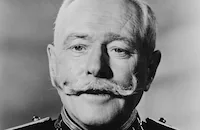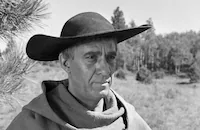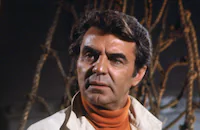A Lady Without Passport

Brief Synopsis
Cast & Crew
Joseph H. Lewis
Hedy Lamarr
John Hodiak
James Craig
George Macready
Steven Geray
Film Details
Technical Specs

Synopsis
Following the murder of a Cuban man on a busy street in New York City, Frank Westlake, the chief patrol inspector for the United States Department of Immigration, begins an investigation into the crime and its connection to an illegal alien smuggling racket headed by a man known as Palinov. Meanwhile, in Havana, Cuba, immigration detective Pete Karczag dedicates himself to the capture of Palinov. Posing as a Hungarian refugee desperate to gain entry into the United States, Pete befriends Palinov and offers him money to secure his passage to America. While waiting for Palinov to introduce him to a smuggler, Pete meets Marianne Lorress, a refugee from Vienna who survived internment in a German concentration camp. Late one night, Pete walks by a nightclub just as Marianne is being arrested for taking employment there without working papers. Thinking fast, Pete wins Marianne's release by posing as her husband. When one of Palinov's henchmen, Harry Nordell, discovers that Pete is really an American agent, he knocks him unconscious and reports his discovery to Palinov. Though Palinov later tells Pete that he knows who he is, Pete vows to continue his search for evidence. Later, however, Pete, having fallen deeply in love with Marianne, makes plans to resign from his job so that he may stay in Cuba and continue his romance. Marianne leaves Pete when Palinov tells her that he is an American immigration agent. Harry is given orders to kill Pete, but Pete manages to overpower him and then forces him to confess that a man named Archer Delby James is the pilot who will be flying Palinov's plane to the United States later that night. After informing Westlake about the illegal flight and its pilot, Pete returns to the United States to help plan the interception of the airplane. Meanwhile, Palinov, realizing that immigration officials are closing in on him, decides to flee Cuba with the next group that James will be smuggling to the United States. Among the six passengers whom Palinov is smuggling is Marianne, but Palinov plans to make her his captive once they arrive in America. As American Navy planes follow the smugglers, Pete, aware that Marianne is on the airplane, monitors the flight's progress with apprehension. When Palinov and James spot the Navy planes, they attempt to escape capture by crash-landing the plane in the Florida Everglades. After they kill one passenger and abandon the others, Palinov and James take Marianne and attempt a getaway on a small life raft. While Westlake rescues the abandoned airplane passengers, Pete takes a motor boat to the site of the crash and finds Marianne with Palinov. Aware that the gas tank is empty and that Palinov will not be able to escape, Pete then trades his boat for Marianne. Once safely in Pete's custody, Marianne accepts the penalty for entering the country illegally, but looks forward to a happy future with Pete.

Director

Joseph H. Lewis
Cast

Hedy Lamarr

John Hodiak

James Craig

George Macready

Steven Geray
Bruce Cowling

Nedrick Young
Steven Hill
Robert Osterloh
Trevor Bardette
Charles Wagenheim

Renzo Cesana
Esther Zeitlin
Carlo Tricoli
Marta Mitrovitch
Don Garner
Richard Crane

Nita Bieber
Mario Siletti
Robert Foulk
Al Hill
Rudolfo Hoyos Jr.

Martin Garralaga

King Donovan
Tom Greenway
Paula Drew
Jay Barney

Paul Picerni
Angela Carabella
David Bond
Frank Francone
Michael Dugan
Jay Lawrence
Nacho Galindo
Ann Codee
Lillian Molieri
Movita
Harry Lang
David Cota
Carl Milletaire
Phyllis Graffeo
George Derrick

Dan White
Arthur Loew Jr.
Gaylord Pendleton
Bret Hamilton
David Clarke
Julia Montoya
Joe Dominguez
Eddie Lebaron
Felipe Turich
George Ramsey
Barry Brooks
Norma Topaz
Ellen Charlesworth
Tom Hern
Tony Roux
Gary Jackson
Rico Alaniz
Nina Bara
Pilar Del Rey
Paul Fierro
Crew
Reggie Callow
Chet Davis
Jack Dawn
Howard Dimsdale
Raymond F. Farrell
Henry Forrester
Cecil W. Fullilove
Cedric Gibbons
A. Arnold Gillespie
Sydney Guilaroff
James Harper
Gene Hibbs
Cyril Hume
Charley Hunt
Ralph S. Hurst
Eylla Jacobus
Conrad Kahn
S. C. Manatt
Sam Marx
Sergei Petschnikoff
David Raksin
June Roberts
Douglas Shearer
Sid Sidman
Frederick Y. Smith
Harry Stradling Jr.
Lawrence Taylor
Paul C. Vogel
Edwin B. Willis

Film Details
Technical Specs

Articles
A Lady Without Passport
After three more box-office flops away from MGM, Lamarr suddenly enjoyed a re-emergence of her career when Cecil B. DeMille cast her as the Biblical temptress in Paramount's Samson and Delilah (1949), which proved to be the highest-grossing film of its year. Mayer, eager to capitalize on his former protégée's renewed popularity, first toyed with the idea of casting Lamarr in Quo Vadis (1951) as Poppaea, a role eventually played by Patricia Laffan.
Instead, Mayer offered A Lady Without Passport, in which Lamarr plays Marianne Lorress, an Eastern European concentration-camp survivor who waits with other refugees in Havana, Cuba, for the American Immigration Department to provide a visa so she can enter the United States. (The film's original title was "Visa.") John Hodiak costars as Peter Karczag, a U.S. Immigration official who has gone undercover, posing as a wealthy Hungarian refugee in order to trap a suave smuggler of human lives called Palinov (George Macready).
With no money and no work permit, Marianne turns in desperation to Palinov to get her to America, which he is happy to do provided the gorgeous refugee gives herself to him in return. Karczag, meanwhile, has fallen in love with Marianne, who in turn rejects him when she discovers he is using her to get at Palinov. Matters reach crisis point when Marianne joins Palinov on a flight carrying illegal aliens that crash-lands in the Florida Everglades.
A Lady Without Passport is a rare big-budget entry in the filmography of its director, Joseph H. Lewis, who more often worked on "B" movies to which he often brought dynamic rhythms and a knack for handling actors. For such melodramas as Gun Crazy (1949) and The Big Combo (1955), he eventually won auteur status among European critics. Lewis' striking visual style is in evidence in A Lady Without Passport -- especially in the Everglades sequence, which is observed from above by a Navy pilot whose plane is circling the site of the crash as the survivors flee into the dense landscape. Another signature Lewis touch: a background teeming with interesting character types.
Despite its flair, A Lady Without Passport did little for Lamarr's career. The general consensus was that she seemed too well-fed and glamorous to be convincing as a concentration-camp survivor; as one wag put it, she looked more like a refugee from MGM's makeup department. She never made another MGM movie, and, although she later appeared in the Bob Hope comedy My Favorite Spy (1951) and a few other films, she never again enjoyed Samson and Delilah-scale success.
Producer: Samuel Marx
Director: Joseph H. Lewis
Screenplay: Howard Dimsdale, Cyril Hume (adaptation), from short story by Lawrence Taylor
Cinematography: Paul C. Vogel
Art Direction: Edward C. Carfagno, Cedric Gibbons
Original Music: David Raksin
Editing: Fredrick Y. Smith
Cast: Hedy Lamarr (Marianne Lorress), John Hodiak (Peter Karczag, aka Josef Gombush), James Craig (Chief Frank Westlake, INS), George Macready (Palinov), Steven Geray (Frenchman, Palinov's Tout), Bruce Cowling (Archer Delby James, Pilot).
BW-74m. Closed captioning.
by Roger Fristoe

A Lady Without Passport
Quotes
Trivia
Notes
The working title of this film was Visa. The onscreen credits for technical assistance read: "The Technical Advice and Assistance of Raymond F. Farrell, Assistant Commissioner, and Cecil W. Fullilove, Investigator, and the U.S. Immigration and Naturalization Service are gratefully acknowledged." Early January 1950 Hollywood Reporter production charts list James Whitmore in the cast, but he did not appear in the released film. A December 1949 Daily Variety news item notes that Peter Coe was to appear in a featured role, his participation in the released film has not been confirmed. Although a January 26, 1950 Daily Variety news item notes that locations were to be shot in Havana, Cuba, this has not been confirmed. This film marked the feature film debut of actor Steven Hill.















